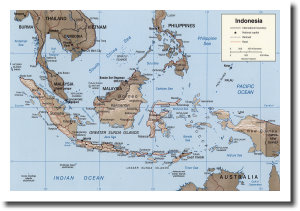

Geography
The country stretches around the equator for 5,150 km (3,200 miles) - roughly the distance between Los Angeles and New York . The comparative map below should give you an idea of the country's size. It is the largest archipelago in the world.
Strategically, the country lies between the Australian and Asian continents and the Pacific and Indian Oceans. Seas and oceans comprise 81 percent of the total area of the Republic. Of its land area of 1,919,440 sq km, rivers and lakes occupy 93,000 sq km and land features 1,826,440 sq km.
Five main islands and 30 smaller archipelagos are home to the majority of the population. The main islands are Kalimantan (1,539,400 sq km), Sumatra (473,606 sq km), Irian Jaya (421,981 sq km), Sulawesi (189,216 sq km), and Java (132,187 sq km). Java alone is home to roughly 70 percent of the country's population!
Indonesia shares the island of Papua with Papua New Guinea and the island of Kalimantan with Malaysia and Brunei Darussalam.
Across the country, the land is generally covered by thick tropical rain forests, where fertile soil is continuously replenished by volcanic eruptions like those on the island of Java . But Indonesia is also mountainous, with some 400 volcanoes, of which 100 are still active.
Climate and Weather
Due to the large number of islands and mountains in the country, temperatures vary. Along the coastal plains, the average is 28°C (82°F); for inland and mountain areas, it is 26°C (79°F); and, in the higher mountain areas, the average is around 23°C (73°F). Like other tropical countries, Indonesia has a high average relative humidity, usually between 73 and 87 percent.
Flora and Fauna
![]()
Ancient Times
Historians believe that Indonesia was linked with the Asian mainland during the Pleistocene period (four million BC). This period was also related to the first appearance of the Hominids; what is today called 'Java Man' inhabited Indonesia as early as two million to 500,000 years ago. 'Java Man' is a short name for Pithecanthropus Erectus , a human-like species whose fossilized remains were discovered by the scientist Eugene Dubois on the island of Java.
![]()
Buddhist and Hindu Kingdoms
Much later, Indonesia developed many well-organized kingdoms. Ruled by indigenous Rajas who embraced the Hindu and Buddhist religions, these kingdoms grew very civilized. Today, this time in history is called the period of Buddhist-Hindu Kingdoms. It lasted from ancient history to the 15th century
The first Buddhists arrived in Indonesia from around 100 to 200 AD from India. One of the most famous Buddhist kingdoms in Indonesian history is Sailendra (750-850 AD). During this period, the famous Buddhist temple at Borobudur was built. The dynasty's replacement, the Hindu kingdom of Mataram began the era of Hindu kingdoms. The mightiest Hindu kingdom in Indonesia's ancient history was the Majapahit Empire. Under the reign of King Hayam Wuruk (1331-1364 AD), the empire enjoyed tributary relationships with territories as far away as Vietnam, Cambodia, and the Philippines.
![]()
Islam Arrives
Gujarati and Persian merchants who embraced Islam started to visit Indonesia in the 13th century. Along with trade, they introduced Islam to the Indonesian Hindus, particularly in the coastal areas of Java. Islam then spread further east to the Bone and Goa Sultanates in Sulawesi, Ternate and Tidore in the northern part of Maluku, and the east part of Lombok. Besides those areas, Islam also expanded to into Banjarmasin, Palembang, Minangkabau, Pasai, and Perlak.
![]()
European Period
European influence in Indonesia began when the Portuguese, in search for spices, landed in 1512. Both the Portuguese and the Spanish spread Christianity in Indonesia. Meanwhile, the Dutch established an organized merchant trade called Dutch East India Company (VOC) in 1602 to tap the rich spices territories. After the seizure of Ambon in Maluku (1605) and Banda Island (1623), the Dutch enjoyed a trade monopoly in the "Spice Islands."
In 1814 the British came to Indonesia. During the Napoleonic wars in Europe, when Holland was occupied by France, Indonesia fell under the rule of the British East India Company. After the fall of Napoleon, the British and Dutch signed a convention in which it was agreed that Dutch colonial possession dating from 1803 onwards should be returned to the Dutch administration in Batavia (present-day Jakarta). Thus, the Indonesian archipelago once again became a Dutch possession in 1815.
Throughout the period of colonization, Indonesians had been fighting for their independence. This struggle, begun in the 1600s, climaxed with a proclamation of independence in 1945, and continued for a few years more.
![]()
Independence
When World War II broke out, the Japanese occupied the Dutch East Indies after the surrender of the Dutch colonial army in March 1942. Three years later, on August 14, 1945, the Japanese surrendered to the Allied Forces. To Indonesia's leaders, the power vacuum in Jakarta looked like an open window of opportunity to proclaim their independence. On 17 August 1945, Indonesian national leaders Soekarno and Dr. Mohamad Hatta proclaimed Indonesia's independence on behalf of the Indonesian people. The proclamation took place at Jalan Pengangsaan Timur No.56, Jakarta, and was heard by thousands of Indonesians nationwide through a secret radio broadcast from a captured Japanese radio station, Jakarta Hoso Kyoku. An English translation of the proclamation was broadcast overseas soon afterwards.
A Diverse Nation
In its ethnic groups, languages, culture, and religion, Indonesia is a very diverse nation. This great diversity is reflected in the country's national motto Bhinneka Tunggal Ika which means "Unity in Diversity."
- Ethnic Groups
Some 300 ethnic groups call Indonesia home, but most (45 percent) of Indonesians are Javanese. In addition, 14 percent are Sundanese, 7.5 percent Madurese, 7.5 percent coastal Malays, and 26 percent are of other ethnic groups. - Languages
There are more than 700 languages and dialects spoken in the archipelago. They normally belong to the different ethnic groups of the population. Some of the distinctly different local languages are: Acehnese, Batak, Sundanese, Javanese, Sasak, Tetum of Timor, Dayak, Minahasa, Toraja, Buginese, Halmahera, Ambonese, Ceramese, and several Irianese languages. To make the picture even more colorful, these languages are also spoken in different dialects.
Bahasa Indonesia is the national language. It is similar to Malay and written in Roman script based on European orthography. English is the most prevalent foreign language. Also, some Dutch is still spoken and understood in the bigger cities and French increasing in its popularity at the better hotels and restaurants. - Culture
Indonesia's active history has encouraged the growth of many unique cultures. On Java, the Javanese of Central and East Java are known for having several layers of formality in their language. In Javanese, to speak to a boss and then to a child is like speaking two different languages. The Toraja of Sulawesi are famous for their elaborate funeral ceremonies. Often several days long, these ceremonies bring the whole village together in a feast, a procession, and a hillside burial. And the Minangkabau of Sumatra still maintain a matrilineal society. Everything from houses to animals is inherited from mother to daughter.
Today, the country maintains this cultural richness, even as it expands into new areas. The traditional music of the gamelan and angklung coexists with new dangdut and rock and roll. The ancient art of wayang kulit, or shadow puppetry, complements the modern Indonesian film industry. And, while the themes and story from historic epics like the Ramayana persist, newer literature like that of the author Pramoedya Ananta Toer has become an irrevocable part of Indonesian culture. - Religion
Six world religions are formally recognized in Indonesia: Islam, Catholicism, Protestantism, Confucianism, Hinduism and Buddhism. Nevertheless, other faiths can be found, especially in isolated societies. These religions, called traditional faiths, are also accepted. According to recent counts, approximately 85 percent of the population is Muslim, 11 percent is Christian (Protestants and Catholics), and 4 percent is Hindu, Buddhist, Confucian, or traditional.
![]()










